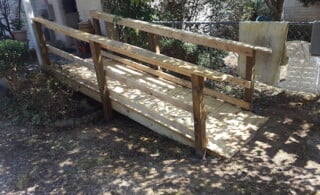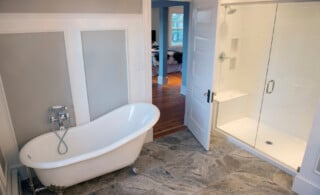
As homeowners grow older, good remodeling design may be the difference between being able to live independently and having to move to a senior living facility.
Years ago, the home design needs of seniors was not often taken into consideration. Now, just about everyone is looking at the way homes are designed and realizing how inappropriate they are for this growing portion of the population. Unless you are planning to move soon, you too should be looking at your home’s design and investigating ways to make it safer and more conducive to long-term independence.
To get the biggest bang for your buck, start early and adopt a long-term approach. Every time you make a change, replacement, or improvement to something around your home, look at the project as an opportunity to make the home a partner in your quest for long-term independence.
For example, if your front walkway is starting to break up and you are considering replacing it, go a bit further with your planning. Is there any way to eliminate some or all of the steps in front of your home? Many homes have a lovely curving walk that winds from the driveway to the front porch. There it terminates at a couple of steps. What if you were to have the repair company re-grade the walk slightly? In many cases a gentle slope in the walk will entirely eliminate the need for steps.
Done as part of a routine improvement or replacement, this new feature is not likely to cost you many, if any, additional dollars. Just as importantly, the new walkway will look like it belongs. It will look like it was meant to be that way, not like the wheelchair ramps that people have to resort to when they haven’t planned ahead.
Wherever you have steps, you need good solid railings. Many original builder railings are little more than decorations. Any time you need a railing repaired, stop and think for a moment. Is it easy to grab? Is it long enough so that you can get a firm grip on it before taking the first step up? What about stepping down? If you were to fall and grab it for support, would it hold your body’s full weight? Most railings don’t really pass muster. Think about replacing an inadequate railing with one that really does the job.
In many homes, short flights of steps may lack railings entirely. That’s an accident waiting to happen.
Here are questions and answers to some of the most common questions about improving mobility into and through the home:
Q: It seems like everyone is always talking about wheelchairs. I don’t use one and none of my friends do either. Why should I bother making my home wheelchair accessible
A: Eliminating steps not only helps those in wheelchairs, it makes things easier for everyone. Think about it. Wouldn’t it be easier if you could roll your luggage right from the living room to the car? Wouldn’t it be great to take the grandkids for a walk and wheel the stroller right into the house? Imagine how much easier grocery shopping would be if you could unload groceries into a small cart and wheel them right into the kitchen. Think wheels, not wheelchairs!
Q: My home has lots of steps, but there really isn’t any way to eliminate them without tearing things down and starting over. What can I do?
A: Unfortunately, this is a common situation. Your best bet is to arrange rooms so that it is workable to live independently (even if only temporarily) on one level. This may mean rethinking the laundry routine. If your laundry equipment is down in the dark depths of the basement, consider creating a laundry alcove or closet near the kitchen.
If your household has shrunk over the years, you might find that you could do fine with a compact washer and dryer pair that fits into a closet. If you don’t have a bedroom on the same floor as the kitchen, investigate ways to make the living room or dining room convertible to a temporary bedroom.
Often, the easiest way to do this is to install pocket doors that allow one of these spaces to be closed off and made private. In the meantime, the doors will give you more flexibility when entertaining and dealing with hordes of grandchildren. Many homes only have a half-bath on the main floor. The next time you do any remodeling or major interior repairs, consider converting the half-bath to a full bath by adding a shower. A shower takes up less space than a tub and it is much easier for most folks to use.
Ready to start your Independent Living Remodel?
Find ProsQ: I live in a ranch-style home with everything on one level. Even my front walk is step-free. What else can I do to help ensure that I get to stay in my own home for as many years as possible?
A: Two other things to consider are how easy your halls are to navigate and whether your floor coverings are appropriate. Many older homes have very narrow hallways. This is often compounded by a lifetime’s accumulation of treasures. Cramped halls are difficult for anyone needing the assistance of a firm hand, a walker, or a wheelchair. Under foot, you want to steer away from deeply padded carpets, which can impede or trip someone with an unsteady gate. Slippery floors are leading culprits in independence-robbing falls. Throw rugs, especially on slick floors, can also be a real hazard.
David Hollies is a remodeling industry educator and consultant. He is also the founder of Washington D.C.-based Home Connections, Inc.
 Remodeling With Seniors in Mind
Remodeling With Seniors in Mind  The Ultimate Guide to Optimizing Your Home for a Service Dog
The Ultimate Guide to Optimizing Your Home for a Service Dog  Home Adaptations for Your Needs
Home Adaptations for Your Needs  Retiring in Your Own Home: How Baby Boomers Can Age In Place
Retiring in Your Own Home: How Baby Boomers Can Age In Place  Modern Design Trends & Advice for Aging in Place
Modern Design Trends & Advice for Aging in Place 

Are You Familiar With This Topic? Share Your Experience.